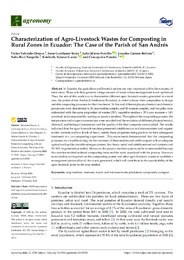Please use this identifier to cite or link to this item:
https://hdl.handle.net/11000/31013
Characterization of Agro-Livestock Wastes for Composting in Rural Zones in Ecuador: The Case of the Parish of San Andrés
Title:
Characterization of Agro-Livestock Wastes for Composting in Rural Zones in Ecuador: The Case of the Parish of San Andrés |
Authors:
Valverde Orozco, Víctor Hugo 
Gavilanes Terán, Irene 
Idrovo Novillo, Julio César 
Carrera Beltrán, Lourdes Cumandá 
Buri, Sofia 
Salazar, Kimberly 
Paredes, Concepcion  |
Editor:
MDPI |
Department:
Departamentos de la UMH::Agroquímica y Medio Ambiente |
Issue Date:
2022-10-17 |
URI:
https://hdl.handle.net/11000/31013 |
Abstract:
In Ecuador, the agriculture and livestock sectors are very important within the economy of rural areas. These activities generate a large amount of waste whose management is not optimized. Thus, the aim of this work was to characterize different agro-livestock wastes generated in a rural area, the parish of San Andrés (Chimborazo-Ecuador), in order to know their composition to design suitable composting processes for their treatment. To this end, different physicochemical and chemical parameters were determined in 24 crop residue samples and 18 manure samples, and two piles were elaborated with the same proportion of wastes (51% vegetable residue + 35% cow manure + 14% sawdust) and composted by turning or passive aeration. Throughout the composting process, the temperature and oxygen concentration were recorded and the evolution of different physicochemical, chemical, and biological parameters and the quality of the final composts were studied. The results indicated that the agro-livestock residues presented notable macro and micronutrient and organic matter contents and low levels of heavy metals, these properties being positive for their subsequent treatment in a co-composting experiment. This experiment demonstrated that the composting processes are a feasible strategy for the treatment of these residues and yield compost with an adequate agricultural quality (notable nitrogen content, low heavy metal and soluble mineral salt contents and 92–94% in germination index). Moreover, the passive aeration system can be recommended because this aeration method reduced composting times and the work associated with the process. However, more studies are required on this composting system and other agro-livestock wastes to establish a management protocol for all the waste generated, which will contribute to the sustainability of the agro-livestock sector in the area studied
|
Keywords/Subjects:
Crop residues
Manures
Macro and micronutrients
Phytotoxic compounds
Compost |
Type of document:
application/pdf |
Access rights:
info:eu-repo/semantics/openAccess
Attribution-NonCommercial-NoDerivatives 4.0 Internacional |
DOI:
https://doi.org/10.3390/agronomy12102538 |
Appears in Collections:
Artículos Agroquímica y Medio Ambiente
|
 ???jsp.display-item.text9???
???jsp.display-item.text9???

.png)
